| |
Strategic Goal: Continually improve the public's access to activities, goods and services through preservation, improvement and expansion of the highway transportation system and the enhancement of its operations, efficiency and intermodal connections.
Strategic Objective: Preserve and enhance the infrastructure of Federal-aid highways with emphasis on the NHS.
Performance Goal: In FY 2001, increase the percentage of miles on the NHS that provide acceptable ride quality to 91.9.
(Note: Rather than change the target in pavement condition, which has been exceeded, the goal owner (and team) is examining options to more precisely identify problem areas. It is anticipated that we will have new measures in Spring/Summer of 2001.)
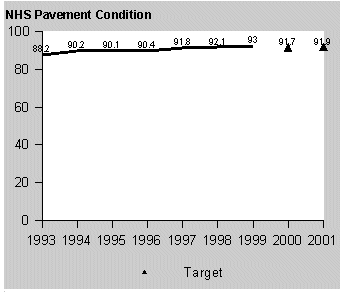
The National Highway System (NHS) consists of 161,117 miles of rural and urban roads—just 4 percent of total highway miles—but carries 1 trillion vehicle-miles-traveled (VMT). That's 43 percent of all VMT. The system serves major population centers, international border crossings, ports, airports, public transportation facilities, intermodal transportation facilities and major travel destinations. The condition of this system affects wear-and-tear on vehicles, fuel consumption, travel time, congestion, comfort, and public safety. Improving pavement condition is key to the long- term structural integrity of the highway transportation system.
Growth in the U.S. economy has contributed to the over 2 percent annual growth in VMT. In addition, industry demand for heavier and longer trucks has increased pavement deterioration. Freight industry projections forecast a 20 percent increase in tonnage over the next five years.
Strategies: The FHWA Federal-aid Program provides funds for projects that improve NHS pavement condition. Most of the funding for these projects comes from the NHS and Interstate Maintenance (IM) programs. Over $4.6 billion in IM funds and almost $5.5 billion in NHS funds will be obligated in FY2001.
Performance Goal: In FY 2001, reduce the number of deficient bridges. (Reduce the percentage of structurally deficient and/or functionally obsolete bridges on the NHS to 22. Reduce the percentage of non-NHS structurally deficient and/or functionally obsolete bridges to 29.7)
(Note: Rather than change the target in bridge condition, which has been exceeded, the goal owner (and team) is examining options to more precisely identify problem areas. It is anticipated that we will have new measures in Spring/Summer of 2001.)
Our nation’s highway transportation system includes about 581,862 bridges serving population centers, international border crossings, intermodal transportation facilities, and important travel destinations. Almost one-third of these bridges are either structurally deficient or functionally obsolete (in terms of dimensions, load, or other characteristics).
The National Highway System (NHS) includes about 128,508 bridges serving major population centers, international border crossings, intermodal transportation facilities, and major travel destinations. Almost 25 percent of these bridges are either structurally deficient or functionally obsolete (in terms of dimensions, load, or other characteristics). Deficient bridges impair the public’s access to activities, goods, and services.
| Performance Measure/Target Percentage of NHS bridges classified as deficient (structurally deficient and/or functionally obsolete) |
Performance Measure/Target Percentage of Non-NHS bridges classified as deficient (structurally deficient and/or functionally obsolete) |
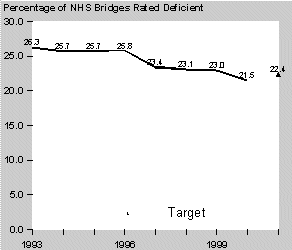 |
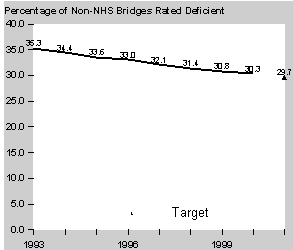 |
Growth in the U.S. economy has contributed to the over 2 percent annual growth in vehicle miles traveled, increasing stress on bridges. In addition, increases in combination truck traffic as well as an aging infrastructure have contributed to the structural and functional deterioration of our bridges.
Strategies: Federal investment will help replace, rehabilitate, and preserve our existing bridges. FHWA will focus on research advances in the technology of bridge design, construction, repair, and maintenance. FHWA technology deployment initiatives will ensure that advancements in high performance materials, improved design techniques, and seismic retrofit techniques are adopted to improve the performance of bridges.
Strategic Objective: Improve the operation of the highway systems and intermodal linkages to increase transportation access for all people and commodities.
Performance Goal: Increase user satisfaction with the Nation’s highway systems and intermodal linkages to meet customer needs.
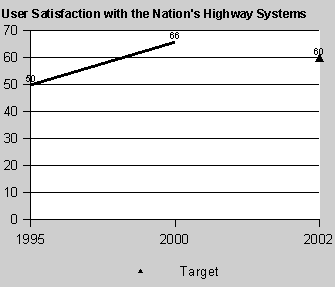
FHWA is committed to excellence in service to its customers and partners. It is important to understand highway users’ perception of how well highways—as part of the Nation’s intermodal transportation system—serve their needs when traveling to work, school, community services, markets, and to visit other people.
Strategies: Increased user satisfaction should be one of the cumulative results of all of FHWA’s programs, services, and activities. The User Satisfaction surveys will focus on both freight transportation shippers/ stakeholders and passengers. Together they will provide insights regarding the effective operations of our highway systems and intermodal connectors.
Performance Measure/Targets
Percent user satisfaction with the Nation's intemodal linkages
The following interim
steps will be taken in FY 2001 to develop the performance measure "Percent
user satisfaction with the Nation's intermodal linkages."
|
Performance Goal: In FY 2001, slow the growth of congested travel and traveler delay.
Congestion is a major problem. From 1987 to 1997, total highway travel increased 2.9% per year while the expansion of our physical highway system increased 0.3%. The disparity resulted in increased congestion. Congested conditions affect the mobility of people and goods at a cost to motorists amounting to over $72 billion annually in lost wages and wasted fuel. Congestion creates user frustration and stress, compromises just-in-time manufacturing processes, drives prices up, and creates problems for American businesses and entrepreneurs to effectively operate within a global economy. The FHWA is confronting the growth of congestion in many ways, i.e., maximizing the performance of our highways through innovative operations, leveraging technology, effective planning, construction, and more. We are developing and executing many "continuous improvements" to help slow the growth of congestion. (see the Mobility Matrix)
Congestion is an area of concern that is reflected in both the Mobility and Productivity goal areas. In the FY 2000 Performance Plan, FHWA used hours of delay per 1,000 vehicle miles traveled (VMT) to measure this goal. This metric attempted to provide a system-wide measure of congestion. However, it represented only one dimension of congestion – delay -- and did not effectively reflect the actual performance of the highway system in places where congestion regularly happens. Moreover, the measure was difficult to interpret by the general public. Based on discussions with our partners and customers, we replaced this indicator with three new measures: Congested Travel, Travel Time, and Traveler Delay. Together, these new indicators will reflect changing travel conditions more comprehensively by focusing on three different aspects of inefficient road performance in a broad collection of urban areas across the nation where congestion regularly occurs. Congested Travel and Traveler Delay are contained within the Mobility section while Travel Time is in the Productivity goal chapter.
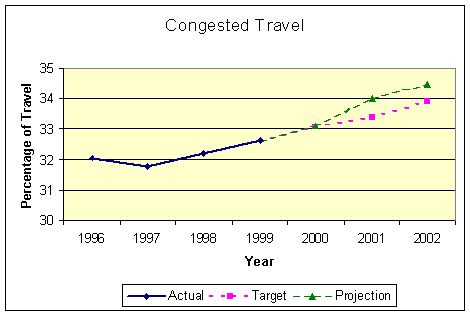
The Congested Travel measure focuses on undesirable traffic congestion. In 1999, 32.6% of daily travel occurred under congested conditions. In 2001, without intervention, 33.6% of daily travel would be expected to occur under congested conditions, assuming a growth rate of 0.5% per year. The Department’s goal is to limit the growth rate of congested travel to no more than 0.3% in FY 2001, resulting in a total percentage of daily travel under congested conditions of 33.4% or less.
Understanding the Table:
The percentage of congested travel measures travel below the posted speed limit. The graph’s figures apply to daily travel within approximately 400 urban areas. For instance, the 1996 figure tells us 32% of daily travel occurs under congested conditions. The FHWA’s goal is to slow the growth of congested travel by 0.2% each year.
Definitions:
The Travel Time measure focuses on the additional travel time necessary for an individual to make a trip during the peak period(s) because of congestion. In 1999, the average peak period trip took 25% longer than the same trip in uncongested conditions. In 2001, without intervention, the average peak period trip would be expected to take 27% longer, assuming a growth rate of 1% per year. The Department’s goal is to limit the growth rate of peak period travel time to no more than 0.4% in 2001, resulting in the average peak period trip being no more than 26.6% longer than the same trip in uncongested conditions.
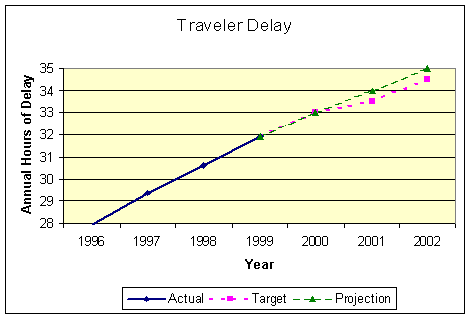
Understanding the Table:
The graph identifies the average number of hours drivers are stuck in traffic. The numbers are derived from approximately 400 urban areas. The hours of delay reflect congestion, incidents, and accidents. From 1996, delay increased approximately 1 hour per year. The FHWA’s goal is to slow the growth of delay time by 30 minutes each year.
Definition
Strategies: Complete key on-going initiatives and invest in a limited number of high impact "low hanging fruit."
In FY 2000 and FY 2001 we will further the deployment of an integrated ITS infrastructure across the United States. Our efforts will be focused on implementing the National ITS Architecture and standards through an aggressive testing and training program that includes the FHWA field staff, state and local governments, and the private sector; fostering the integration of ITS technologies in metropolitan and rural areas through the development of ITS service plans and the implementation of the ITS Integration program; demonstrating statewide and rural ITS services through a growing rural operational test program; and advancing the state-of-the-art in metropolitan ITS infrastructure through continued research and development.